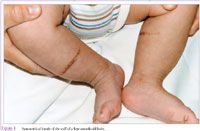Case: Bands on the calves of a 4-month-old
A 4-month-old infant is brought in due to raised hyperpigmented lesions around his shins.
» What's the diagnosis?» How would you treat him?
The mother of a 4-month-old infant asks for your sleuthing skills in discovering the cause of symmetric bands around the legs of her baby. The baby appears vigorous, and is feeding and growing well.
Diagnosis: Linear plaque

Clinical findings
There was no predisposition to atopy, or family history of similar lesions. No history of preceding rash or trauma or similar lesions elsewhere in the body. The mother reported that she started using socks that were loose around the ankles approximately five weeks ago, as she associated the lesions with wearing socks that were too tight. The redness and swelling resolved, leaving brown rings that failed to improve with the application of olive oil and other topical home remedies.
Examination revealed a linear raised circumferential palpable lesion symmetrically on the medial aspect of both calves. There was no area of constriction or skin folds noted. A complete medical examination failed to demonstrate any systemic or other skin findings. No investigations were carried out, and no treatment was instigated.
Our patient
The history of exposure, the nature of the band, and course of the lesions following elimination of tight socks implicate the elastic sock band as the culprit for this condition. The authors have observed two additional cases of curvilinear lesions along sock lines, which presented with hyperpigmented plaques that regressed without treatment over several months. The parents were counseled and reassured accordingly, and the infants were followed closely.
Pathogenesis
Tight elastic bands probably cause ischemia, and resultant injury and inflammation of the underlying soft tissue may lead to scarring long after the irritant factor has been removed. Depending on the length of time and frequency of application and pressure of the band, investigators have suggested that panniculitis and subcutaneous necrosis may result in varying persistent cutaneous changes.1
Most of the 12 reported cases which occurred in full-term and pre-term infants1-6 were noted between 1 and 4 months of age. Lesions were reported on the calf marking the sock-line termination, and were unilateral or bilateral. Most were hyperpigmented and persisted for several months after the causative agent was removed, similar to our case.
The first two cases reported by Zhu in 2002 were initially mistaken for congenital linear hyper pigmentation, and skin biopsies revealed lentigenous melanocytic hyperplasia.5 Marque described three cases that were localized to the elastic bands of the socks, suggesting a traumatic etiology. Histology of these cases revealed an infiltration of adipocytes into the upper dermis.1 These cases were identical to the patients seen in the authors' clinic, and an additional series reported by Berk.3,4 Recent reports emphasize the innocent nature of this process, and discourage biopsies when the classic clinical history and findings are present.4
Recognize & Refer: Hemangiomas in pediatrics
July 17th 2019Contemporary Pediatrics sits down exclusively with Sheila Fallon Friedlander, MD, a professor dermatology and pediatrics, to discuss the one key condition for which she believes community pediatricians should be especially aware-hemangiomas.